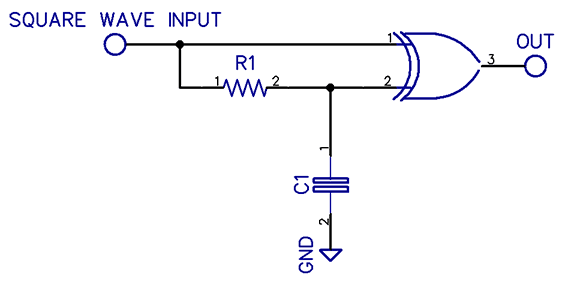Hi all, hoping someone can help out.
I'm looking for a circuit which will double the frequency of an input square wave.
The input wave has a 50% duty cycle (I'm told), 0-12v amplitude a and will vary from 25Hz -> 200Hz.
The output would ideally be 50% duty but amplitude could be 0-5v if that was more convenient. I'm assuming there would be some propagation delay as the output would not be 'known' until after the input cycle hence at least one cycle delay. This should be OK.
I'll give some background to the requirment as this may help the solution (or at least eliminate some).
The output is a tachometer signal from an electronic ignition system for a petrol engine. The standard output is 2 cycles per revolution (4 cyclinder, 4 stroke engine, coils fire twice), however this is being used on an 8 cyinder engine and its tachometer is expecting 4 pulses per revolution. OK, I could get a tachometer which requires only 2 pulses per rev' (or possibly even modify the one I have) but unfortunately this signal also feeds the fuel injection system which I don't have the facility to change or modify.
Ideally I'd like to NOT rely on the 50% duty cycle nature of the input signal as I'm taking this on trust but if it's the only way to make this work I'm happy to give it a go.
I have some electronics ability but a bit rusty. Any help greatfully received.
I'm looking for a circuit which will double the frequency of an input square wave.
The input wave has a 50% duty cycle (I'm told), 0-12v amplitude a and will vary from 25Hz -> 200Hz.
The output would ideally be 50% duty but amplitude could be 0-5v if that was more convenient. I'm assuming there would be some propagation delay as the output would not be 'known' until after the input cycle hence at least one cycle delay. This should be OK.
I'll give some background to the requirment as this may help the solution (or at least eliminate some).
The output is a tachometer signal from an electronic ignition system for a petrol engine. The standard output is 2 cycles per revolution (4 cyclinder, 4 stroke engine, coils fire twice), however this is being used on an 8 cyinder engine and its tachometer is expecting 4 pulses per revolution. OK, I could get a tachometer which requires only 2 pulses per rev' (or possibly even modify the one I have) but unfortunately this signal also feeds the fuel injection system which I don't have the facility to change or modify.
Ideally I'd like to NOT rely on the 50% duty cycle nature of the input signal as I'm taking this on trust but if it's the only way to make this work I'm happy to give it a go.
I have some electronics ability but a bit rusty. Any help greatfully received.



